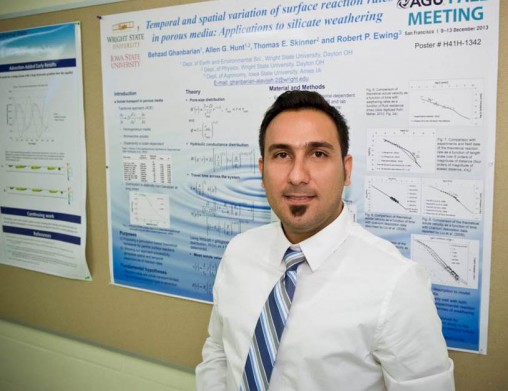
Environmental sciences Ph.D. student Behzad Ghanbarian is a prolific scholar, publishing many papers on soil-related research.
On Salsa Night at Dayton’s Therapy Café, chances are you will find Behzad Ghanbarian tearing up the dance floor. The Wright State University graduate student from Iran finds release in the feverish Latin moves.
When it’s not Salsa Night, Ghanbarian can usually be found in front of his computer screen conducting research and working on his next paper. The environmental sciences Ph.D. student—who is rocketing to the top of his field—has practically become a publishing house.
Ghanbarian has 10 published papers in peer-reviewed Iranian journals and 26 in peer-reviewed international journals. Eighteen of those have come since he arrived at Wright State in 2010.
His papers focus largely on soil-related topics, with titles such as “Universal Scaling of Gas Diffusion in Soil Media to Evaluation of Soil Texture Data for Estimating Soil Water Retention Curve.” And he has co-authored a book titled Percolation Theory for Flow in Porous Media.
“I enjoy writing papers; I enjoy publishing papers,” he said. “I want to be a really good scientist in the porous-media community. In order to reach my goal, I have to do research over and over.”
Ghanbarian’s mentor—physics professor Allen Hunt, Ph.D.—calls Ghanbarian’s accomplishments “extraordinary,” adding that his published papers outnumber those of many full professors.
“He also has collaborations that he established without any help from me with scientists in Brazil, Cuba, Italy, Iran and China, among others, meaning that he has established collaborations in North and South America, Asia, Europe and Oceania,” Hunt said.
Ghanbarian grew up in the central Iranian city of Isfahan, the youngest of four children and whose father was the head of a major national bank. He won a scholarship to Isfahan University of Technology to study irrigation, calculating the design and placement of irrigation and drainage systems to prepare land for farming.
After obtaining his bachelor’s degree in 2005, Ghanbarian began working on his master’s at the University of Tehran, where he became interested in fractal geometry.
Fractals differ from regular geometric forms because they are complex figures such as snowflakes or tree leaves that must be measured using different scales to compare how the pattern changes. For example, the length of a coastline differs depending on the scale of the measuring stick.
For his master’s project, Ghanbarian worked with a University of Tennessee professor to investigate evaporation in agriculture by imaging tree leaves and counting the number and distribution of stomata, or pores.
“You want to know how much water is getting out, and you have to get it back by irrigating,” he said. “The results were really interesting.”
As he rose in agricultural academic circles, Ghanbarian remained laser-focused on his career. Once while conducting research in Trieste, Italy, he chose to remain glued to his computer screen while fellow students went sightseeing in the beautiful, fairy-tale city of Florence. (Ghanbarian still gets that wish-I-would-have-done-that look in his eye.)
While he was doing research for his Ph.D., Ghanbarian discovered a paper written by Hunt, began communicating with him and in 2010 enrolled in Wright State’s environmental sciences Ph.D. program.
Hunt is a pioneer in porous media—hydrology, hydro geology and soil physics—and an expert in fractals and percolation theory.
“Nobody had done what he had done,” Ghanbarian said. “Coming to Wright State and working with him was a dream come true. It was the best choice I ever made in my academic life.”
In 2013, Ghanbarian won Wright State’s Graduate Student Excellence Award. In the meantime, he continues to write and publish papers.
“In my life, there is no time to waste,” he said. “If I don’t have a topic to work on, I read other articles. I get ideas from an article, compare it to previous ideas and come up with a new idea.”
Ghanbarian plans to do post-doc work at the University of Texas at Austin in petroleum geosystems engineering beginning in July.
“They want to know how water or oil flows through the media, so we’re going to have some numerical simulations that I’ve never done before,” he said. “I like it because any time you learn something new, that means you are alive and moving forward.”
Just like salsa dancing.

 Wright State Police Department delivers major donation to Raider Food Pantry
Wright State Police Department delivers major donation to Raider Food Pantry  Wright State engineering and computer science students earn prestigious federal SMART Scholarships
Wright State engineering and computer science students earn prestigious federal SMART Scholarships  Wright State Police Chief Kurt Holden selected for prestigious FBI National Academy program
Wright State Police Chief Kurt Holden selected for prestigious FBI National Academy program  Wright State’s Raj Soin College of Business ranked among the best for entrepreneurs by Princeton Review
Wright State’s Raj Soin College of Business ranked among the best for entrepreneurs by Princeton Review  Wright State’s annual Raidersgiving draws hundreds
Wright State’s annual Raidersgiving draws hundreds 